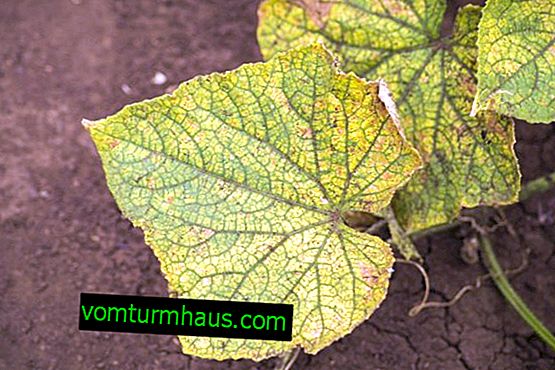Asparagus Sprenger: home care
Sprenger asparagus is an ampoule shrub plant from the asparagus family. In the wild, found in the subtropical forests of South Africa. In our latitudes it is grown as decorative at home and in open ground.
Botanical description of the plant
Sprenger asparagus includes more than 250 subspecies that are found in subtropical climates around the world. They are perennial grasses, shrubs and vines. Belongs to creeping ampelous varieties with a well-developed root system. Previously, asparagus was attributed to the family of liliaceae due to the shape of the flowers, and later reclassified as asparagus.
Did you know? Under ideal growing conditions, asparagus shoots grow by 20 cm per day. The stems are up to 150 cm tall. As a result of adaptation to the arid climate, leaves are underdeveloped, have a prickly or scaly shape, therefore, in the photosynthesis function, flattened branches located in bunches are mainly involved.
It blooms in March and April. Flowers are formed mainly in the leaf sinuses. The shape resembles small lilies collected in panicles. Flowers are painted white.
Photo gallery








After flowering, rounded fruits of a bluish-green color are formed, containing 3 large seeds with a dense black skin covering the germinal body.
| Root system | Fibrous |
| Stem | Thickened |
| Leaf shape | Scaly, prickly |
| Leaf color | Green |
| Flower shape | Lily-shaped |
| Color of flowers | White |
| Fruit shape | Rounded |
| Fruit color | Bluish green |
| The number of seeds in the fruit | 3 |
House growing conditions
Asparagus is often used for landscaping office and residential premises. Plants have an attractive decorative appearance and are unpretentious in care. Cut branches of asparagus retain their appearance for a long time, which allows them to be used in composing bouquets.
Accommodation
When choosing a place for asparagus, keep in mind that the plant needs good diffused lighting. The best place for asparagus is the west or east window.
Important! To increase the immunity of plants, in the summer, take them out daily for several hours under bright sunlight.
Temperature mode
In summer, the comfortable temperature for asparagus is +20 ... + 25 ° С, in winter - +14 ... + 17 ° С.

Air humidity
Asparagus is hygrophilous. In the summer, do not let the soil dry out. The optimum air humidity for a flower in summer is 70–80%, in winter - 60%. Humidity is easily adjusted by spraying twice or installing a humidifier in the room.
Home Care
Asparagus requires minimal care. Pay attention to watering and spraying.
Watering
In order for asparagus to develop a lush crown, follow the rules of watering:
- use standing water that does not contain chlorine compounds;
- water temperature should be at least +20 ° С;
- watering by adding water to the pan, and not under the root;
- in the heat daily spray branches.

Top dressing
Fertilize from early March to October once a month. Use mineral complex fertilizers for indoor flowers and organics, alternating them. For example, in March, add mineral compounds, in April - horn shavings.
Elements that must be present in a complex fertilizer for asparagus:
- nitrogen;
- potassium;
- magnesium;
- calcium.
Learn more about what and how to feed indoor plants at home.
Pruning
For asparagus, 2 types of pruning are performed:
- Formative - helps to simulate the shape of the bush and accelerate the development of new shoots.
- Sanitary - involves the removal of bald, dried, diseased branches or pests.

Transfer
Asparagus is a fast-growing ampel plant, and therefore requires frequent transplantation. Up to 3 years old plants dive annually. Adult specimens are transplanted every 2 years. Perform these procedures in the spring, in March-April.
Pots pick deep and spacious. For full development, plants require loose soil with a neutral pH - in the range of 5.5–7. You can use the store universal primer for decorative leafy plants, adding 20% vermiculite or perlite to it, or mix the soil yourself, combining in equal proportions:
- sand;
- peat;
- leaf-sod soil;
- clay-soddy soil.
Video: Asparagus transplant
Disinfect the ground with Fitoverm (according to the instructions supplied with the preparation). Transplant using the transshipment method:
- 12 hours before the transplant, water the plants abundantly. This facilitates the procedure for extracting roots from the pot.
- Having prepared a new pot, fill it with expanded clay, then lay a layer of soil. The container should be approximately 1/3 full.
- Tilt the pot with the plant slightly down with one hand, and dig the other into the ground and extract the contents. If there are overgrown roots, they must be removed.
- Place the plant in a new pot and sprinkle with soil.
- Having slightly condensed and moistened the soil, send the pots for several days to a room with dim lighting.
- After a week, asparagus can be placed in a permanent place.
Breeding
The asparagus of the sprenger propagates in two ways:
- Cuttings.
- The seeds.
Cuttings
Cuttings are harvested during forming pruning. Planting material should not be shorter than 12 cm. Cut the cuttings soak for 2 hours in a solution of "Kornevina", then root in moist sand.

Seed cultivation
Sowing seeds is carried out at the end of winter. Germination requires light, breathable soil. To obtain it, mix the universal soil mixture with sand. Soak the seeds for 24 hours in a weak solution of manganese. Sow better in cassettes.
Place the seeds on the surface of the soil and sprinkle with sand. There are 2 seeds per branch of the landing capacity. In the common boxes between pairs of seeds, keep a distance of 5 cm. Then wrap the containers with foil and put them in a darkened room. During the germination period, maintain the room temperature within +25 ° C. Remove film daily for 15–20 minutes. Seed germination takes 3-6 weeks.

Possible growing difficulties
When growing asparagus, you may encounter the following difficulties:
- fungal diseases - with the appearance of any type of rot, it is necessary to remove damaged parts of the plant, transplant with a complete replacement of an earthen coma and a disinfection bath for roots;
- the scabbard and the spider mite - insects are removed first by hand, then the treatment with Fitoverm is carried out.
Reviews
after transplantation, it is better to put the asparagus in a darker place, it does not welcome sunlight. But I am sure that he will adapt and will not hurt. I keep an asparagus on a shelf 3 meters from the window, it is lit enough, but direct sunlight does not fall. I can not stand it on the balcony, since it fades, the leaves become pale. By the way, he loves top dressing. I often do foliar top dressing "Tomato Agricola". irishka //forum.bestflowers.ru/t/asparagus-asparagus.1383/#post-33406



